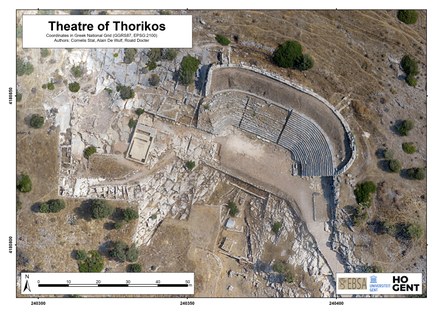Do your bit for the theatre of Thoricus
In the south-east of Attica, the hinterland of Athens, lies the ancient mining town of Thoricus. This is the strategically placed centre of the silver and lead mines of Laurion, and Belgian archaeologists have been doing research here since as early as 1963. When Athens was at its peak, in the 5th century BCE, the silver from Laurion formed the basis of the Athenian economy. There is a very famous story about the Athenian statesman Themistocles. Upon the discovery of a very rich silver vein, he convinced the citizens of Athens to invest the proceeds in the construction of a war fleet consisting of triremes. Thanks to his foresight, Athens was able to defeat the Persians in 480/479 BCE, and thereafter position itself as the great power in the Eastern Mediterranean. However, archaeological research has shown that silver had been mined in Thoricus many centuries earlier, since the Early Bronze Age (c. 3200-2000 BCE).
Multidisciplinary research
The archaeological research that is organised and coordinated by Ghent University is very interdisciplinary, involving close collaboration between historians, geographers, geologists, geomorphologists, hydrologists, mining specialists, zooarchaeologists and palaeoecologists. Alongside Ghent University, teams from the University of Liege, Utrecht University, the Georg-August Universität Göttingen, the University of Lorraine (Nancy), and the Ionian University (Corfu) are also involved in this big project.
The Theatre

Although archaeological excavations were carried out in the 1960s, and a detailed stone plan of architecture was also made, nothing has ever been published about this monument except for a preliminary report. The Greek Archaeological Service has recently conducted research in the orchestra area of the theatre due to stabilisation works, and this has resulted new data, however these also remained unpublished. Together with Greek colleagues from the Ionian University of Corfu, the team from Ghent now wants to complete the long-awaited final publication. This will require both a thorough examination of the old and new finds and architecture and also a few additional small excavations.
Funds are still needed to complete this research project. These will mainly go towards the restoration of the finds and professional digitisation of the drawings of the finds. You can make a donation via bank transfer to the University Fund: BE26 3900 9658 0329 (BIC: BBRUBEBB) including the message “Thoricus LW-619’.
For donations worth €40 or more, you will receive a tax receipt allowing you to claim back 45% of your gift in your tax declaration.
Would you like to find out more about this project? Be sure to take a look at the website www.thorikos.be .